Nomisma
Location: Mechanus
Nomisma is a burg that’ll probably have you holding tight onto your wallet. Imagine a town that’s not built on a cog, like the rest of the plane of Mechanus, but onto both faces of an enormous, gleaming coin. The whole place spins ever-so slowly on its edge, balanced dead-centre on a large smooth cog, like some power set the coin-burg pirouetting with a flick of their wrist and promptly forgot about it.
The coin itself is beyond enormous; it’s at least ten miles in diameter. The face is intricately carved with geometric symbols, abstract figures, and the images of all known power of commerce, as well as many more who the graybeards have yet to identify—perhaps ancient powers who’ve been dead-booked or forgotten, or perhaps powers yet to arise?
The inscriptions aren’t just decorative, they’re alive with currency magic, an obscure arcane school that’s been perfected by the Numismatists, the curious—and fabulously wealthy—sect of scholars, merchants, bankers, and mages who run the show in Nomisma. These bashers believe that trade and currency aren’t just tools of mortals, but the literal lifeblood of the cosmos, greasing the gears of Mechanus itself.
Money makes the gears go round
—Numismatist creed, and now a popular song
The two faces of Nomisma each serve a distinct purpose. They are officially called the District Aureate and District Mercantile, but they’re more commonly abbreviated as ‘Heads’ and ‘Tails’. The heads side of the burg-coin houses the Currency Guilds, the Mint, and the Temple Banks. It’s a hotspot for all things monetary, and it’s also the seat of power of the Numismatist sect. The tails side is home to the Bazaar of Gilded Thought, a sprawling market but not just for physical goods, oh no. The Bazaar in Nomisma is also a market of ideas, where you can buy and sell things you’d never dreamed possible.
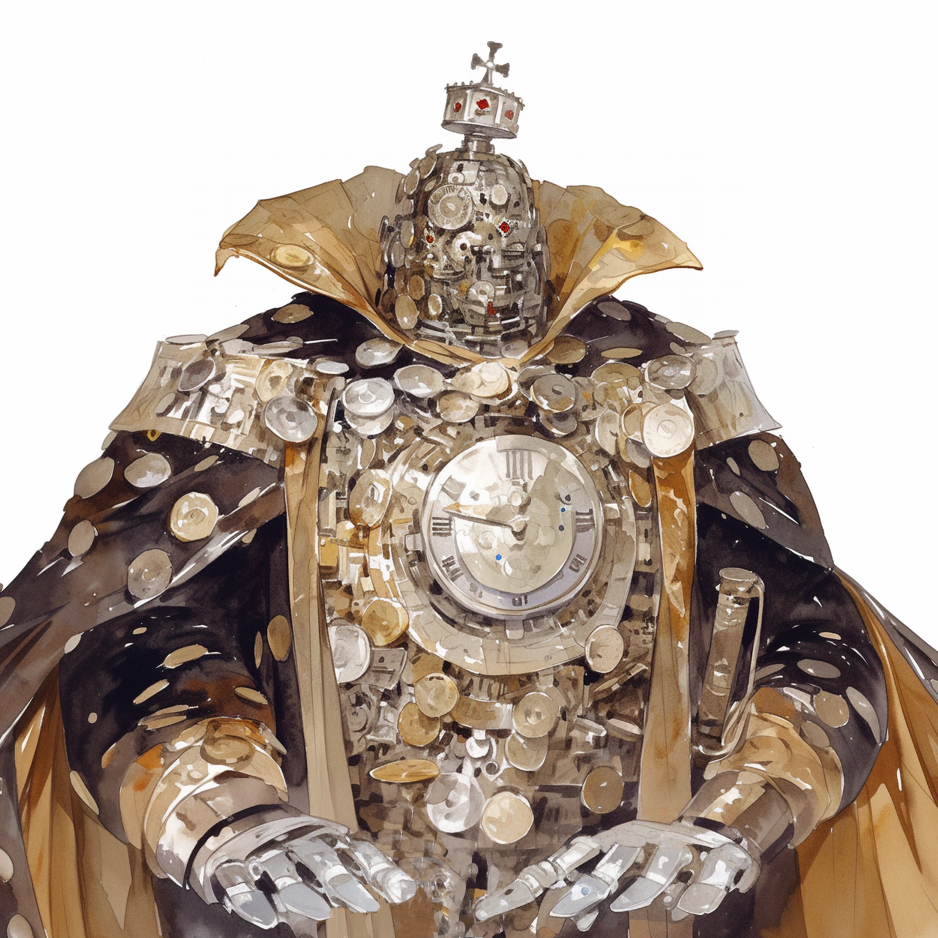
Deep down inside the burg-coin, burrowed far down beneath both faces into the metal, is the Trove, a vast vault and endless labyrinth of wealth. And finally, the Milling Quarter is the secretive part of the burg where shady and legally questionable transactions occur, away from the oversight of authorities.
Who Rules: On its shining surface, Nomisma is a city without a single clear ruler. The burg presets itself as a place where power is said to be controlled by market forces, wealth, influence, and cold, hard logic. Most cutters would agree though that the most influential blood in town is Exarch Chrysmos (planar construct [they/them] / Numismatists / LN), a clockwork humanoid who serves as the Warden of Worth—the highest-ranking Numismatist and de facto ruler of the burg. Chrysmos, a being apparently composed of precious metals and enchanted gemstones, is famous for their impartiality and mathematical precision in all things. Their decisions are as cold and precise as the ticking gears of Mechanus, and their economic policies are treated as immutable law. Most bashers believe that Chrysmos is some kind of advanced construct, and is dubbed the ‘Money Golem‘ behind their back. The dark is that Chrysmos is indeed entirely mechanical but is also very much alive; think an inevitable but one obsessed with economics rather than justice.
Chrysmos governs the Numismatists and hence the city’s commerce with an unflinching hand on the purse strings, overseeing the ‘Nomismatic Flux’, the mystical economic current that travels through the air like invisible streams of wealth, shifting in response to every deal, trade, or theft made in the city. Under Chrysmos, the city’s economy hums like a perfectly tuned machine. His proclamations are clear, his leadership steady. But as with most things in Nomisma, what you see is only part of the equation.
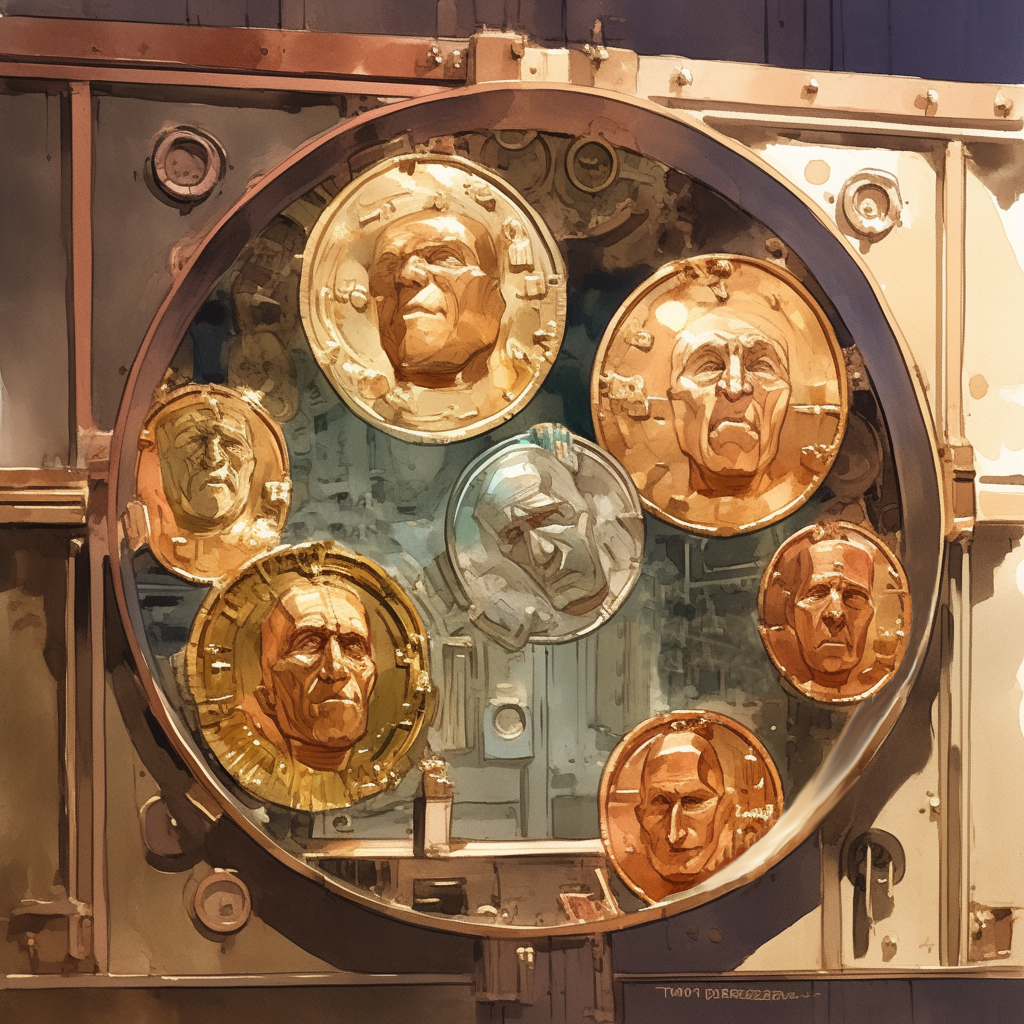
Who Really Rules: Unknown even to Chrysmos, a hidden group of ancient entities are the real powers behind the curtain. The Coin Lords aren’t your run-of-the-mill council of merchants or politicians, but actually a shadowy cabal of five powerful, sentient coins—yes cutter, coins—that hold dominion over Nomisma’s market forces. Each coin represents a concept tied to the foundations of commerce and value, with each face of the coin symbolising an opposing pair of concepts. One coin embodies Avarice and Munificence, another one Trade and Tariff, another Debt and Credit, another Taxation and Subsidy, and a final one Value and Frivolity.
Now, these strange beings don’t move or speak directly, indeed they are safely stashed away in the Deep Vault of Nomismia, but they are able to read and shape the Nomismatic Flux that the cutters in this burg believe impacts upon every trade or exchange in Mechanus, and some would argue, the multiverse. The Coin Lords are the reason that substances like gold have a greater intrinsic value than others, or the reason that some people feel compelled to save money while other hoard it jealously. They’re even behind the concept of taxation being used by governments to raise money for societies to flourish.
The Coin Lords reside in a part of the burg that few know about, the Vault of First Mints, a chamber deep inside the great coin that Nomisma rests upon. If you listen carefully when you jangle a money pouch in Nomisma, you can hear the faint whispers of a Coin Lord calculating value or exchange rate. Every economic decision in Nomisma is subtly influenced by them, from market trends to the sudden rise and fall of currency values across the planes.
Only a select few Numismatists even know of the Coin Lords’ existence, and they work as intermediaries, following the cryptic desires of these ancient entities. Chrysmos is quite literally a puppet, but doesn’t even realise it. The Coin Lords feed them equations, outcomes, and probabilities, allowing Chrysmos to maintain an illusion of control while the Lords subtly push the burg’s economy towards their grand designs.
The Auditors
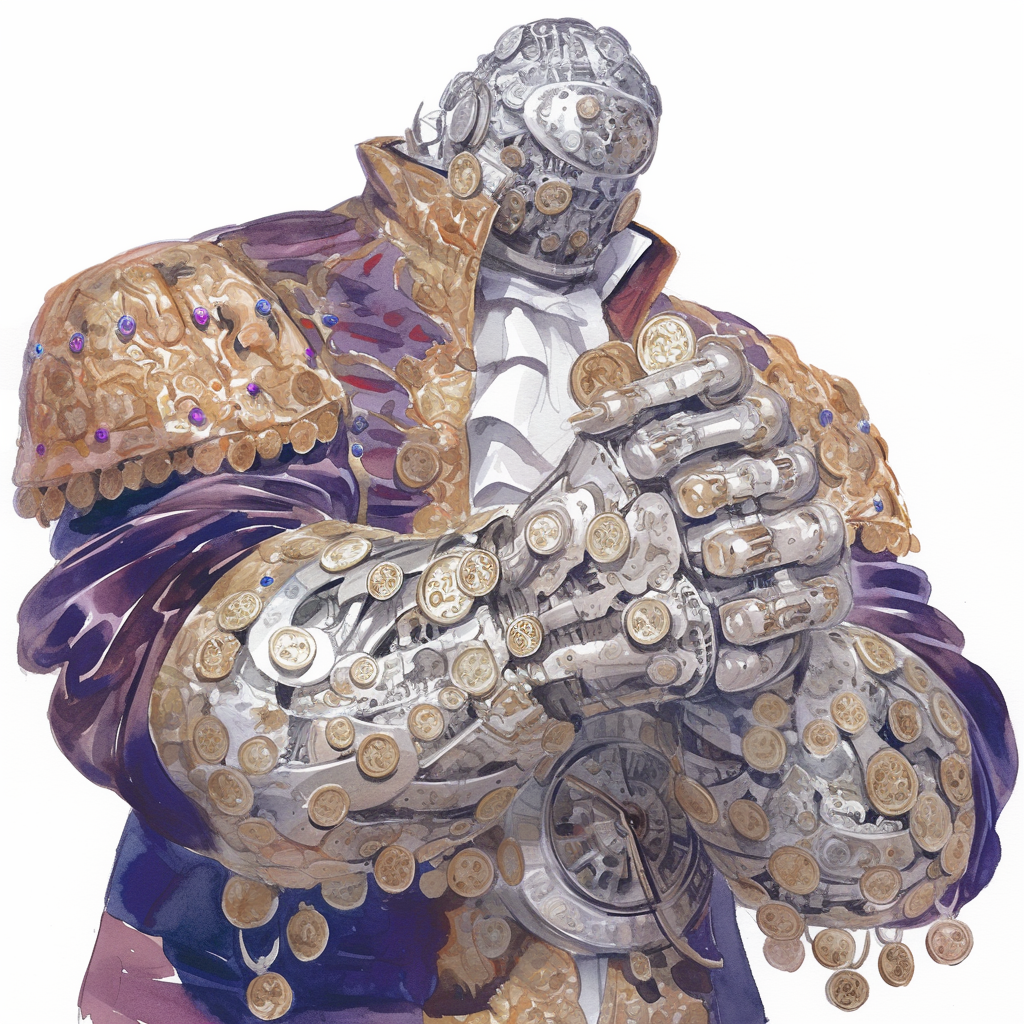
Now, no city this obsessed with currency could function without enforcers, and that’s where the Auditors come in. These mechanical beings, forged by the Numismatists from gold, silver and even soulsteel, vigilantly patrol the streets of Nomisma. Their presence is not just for protection from thieves and bandits—although the markets and vaults of the burg are a tempting target for sure—but they are also protectors of merchants and customers. The Auditors can tap into the nomismatic flux and calculate the exact value of goods, actions or ideas as easily as a student flips an abacus.
Got caught pocketing something from the Bazaar? The Auditors won’t just haul you off to jail—they’ll deduct from your value. Steal a diamond, you might lose a year of your life in retribution. Cheat on a contract, and you might wake up with half your memories missing. The Auditors enforce the law with precision, and every punishment is a transaction. In Nomisma, even justice has a price tag.
The Heads Quarter
The District Aureate
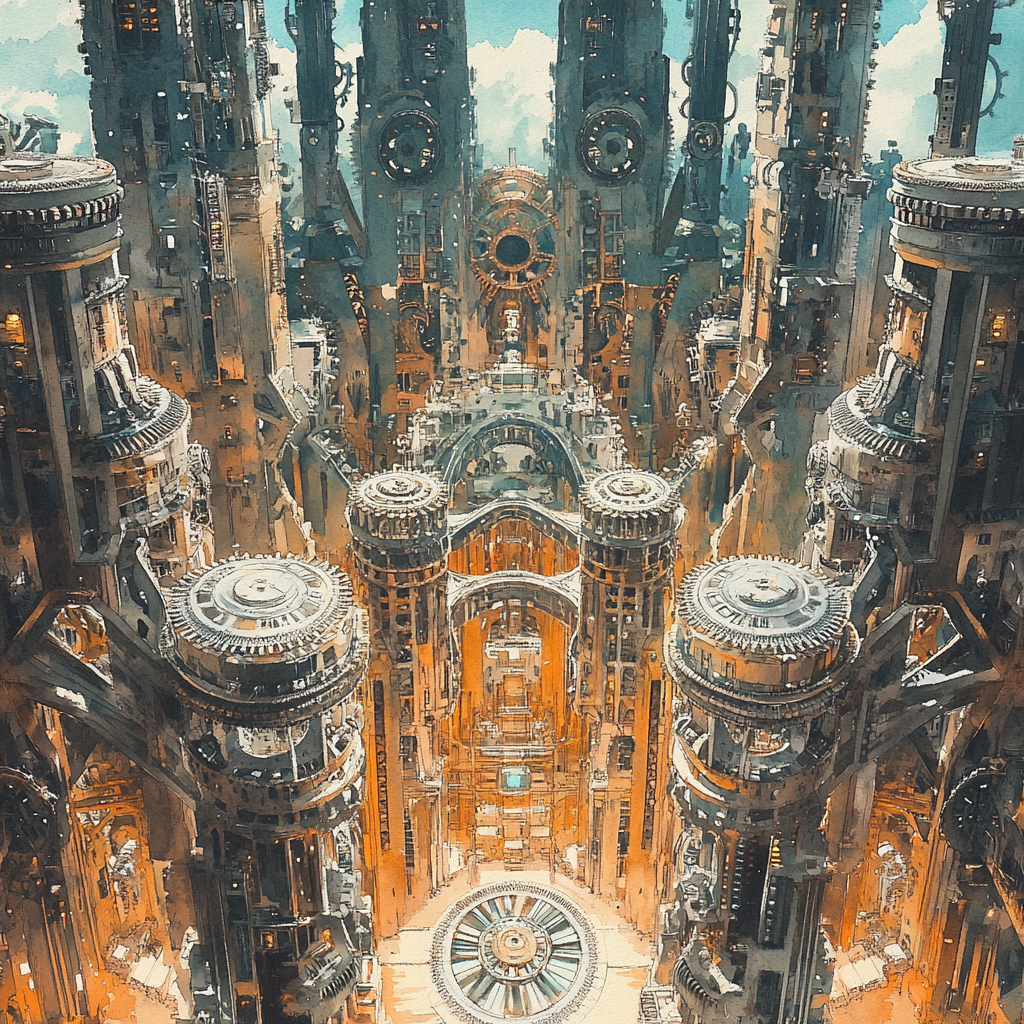
This side of the burg-coin houses the Currency Guild, the Mint, and the Temple Banks. It’s a hotspot for all things monetary, and the headquarters of the local sect in the Numismatic Academy.
The Currency Guild: This is run by a cadre of cutters calling themselves the Argentarii. The silvermongers who work in this area can be found everywhere, in stalls, shops, private residences, and the Forum. They provide all sorts of simple financial services, such as issuing loans, exchanging currencies, providing credit at auctions, depositing money in the Trove, and determining the authenticity and quality of coinage. To be a successful argentarii you need to be a fast and accurate bean counter, scrupulously honest, and free of any vices like gambling. It’s not a particularly lucrative role, but a future priest-banker has got to start somewhere. The Currency Guild tends to employ moigno for their calculation efficiency, making the Forum something of a mathematical hotspot in Mechanus as well. While the Numismatists outnumber them, you’ll find Guvners and Mathematicians here in quantity too.
The Mint: This is the industrial heart of the burg. The musical clang of coins being struck is the first thing a body will notice, as well as the pungent smell of metal smelting. The Mintworkers (also called the Nummulari) are responsible for bringing in and testing metals, smelting, and stamping new coinage. The Bastion of Bullion is the centrepiece here; a spectacular building of burnished gold spires and clockwork gargoyles, well-guarded by Auditors to prevent any precious currency from going astray.
The Temple Banks: Who can you trust to look after your money if not the Powers of Wealth? There are temples devoted to Hades, Waukeen, Zilchus, Rosmerta, Vergadain and Áine here, an embarrassment of riches when it comes to choice. The banker-priests are called Mensarii and because of their piety they’re generally trusted with the larger transactions. The more benevolent churches of Rosmerta and Áine offer loans to sods who’re down on their luck, while the more materialistic temples of Hades and Zilchus tend to cater to richer clientele.
The Tails Quarter
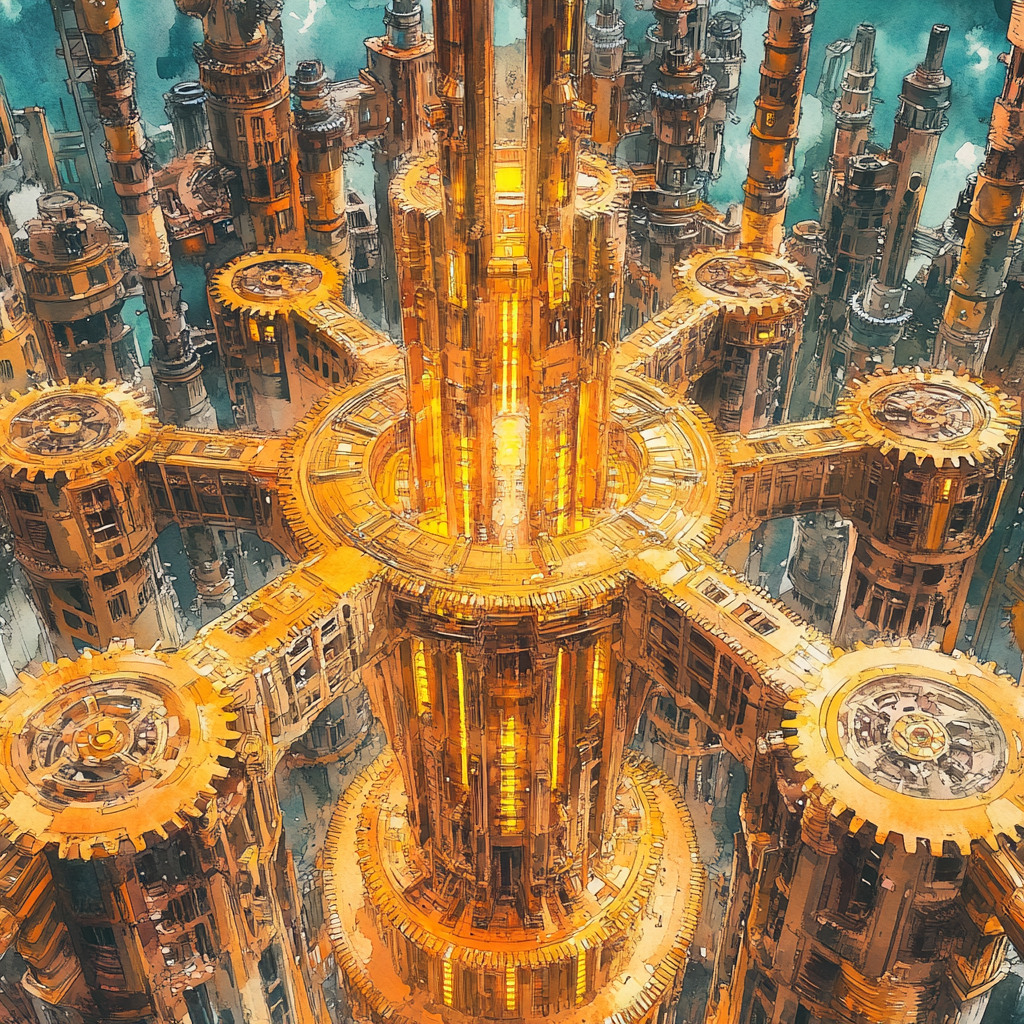
The District Mercantile
The Tails Quarter is a sprawling marketplace, certainly the biggest in Mechanus, even rivalling the gate town of Tradegate or the realm of Marketplace Eternal. The first stop you’ll want to make here is the Bazaar of Gilded Thought. A series of revolving disc levels places linked by walkways and towers, the Bazaar is the sprawling central market of the burg, But don’t let the word bazaar fool you—this isn’t your average planar fleamarket. While there are some levels that cater for mundane concept like food and bub, the more interesting transactions here aren’t physical, they’re mental. For example:
- Bottled Epiphanies. Sold in delicate crystal vials, these epiphanies range from the trivial (“Why cats always land on their feet”) to the profound (“The secret of eternal contentment”). Swig one down, and the revelation will hit you instantly, as if you’d come to the thought yourself. Some claim to have glimpsed fundamental truths about the planes, though be warned—once it’s yours, it can never be forgotten, no matter how much you might wish otherwise.
- Mirrored Memories. Stalls peddling these have curious, reflective screens, where memories are sold — for the right price. They can be your own, or borrowed from others. You might buy the memory of a dragon’s first flight, the joy of a faerie queen’s dance, or the sorrow of a lover’s last goodbye. It’s perfect for those who want to learn or feel something beyond their own experiences—and is extremely popular with Sensates.
- Philosophical Parasites. These tiny, shimmering creatures latch onto your mind and whisper thoughts, questions, and riddles at odd hours. Each parasite brings a different philosophical bent—one might constantly ask you to ponder the nature of identity, while another might obsess over determinism versus free will. They’re perfect for seekers of wisdom, or for those who’d like a little extra voice in their head (for better or worse).
- Syllables of Power. Words from long-lost tongues and forgotten spells, sealed in jars or engraved on stone tablets. Some folk buy them to complete spells, while other cutters believe these words hold ancient secrets. A few peddlers even claim certain syllables can alter reality in subtle ways when spoken with the proper conviction.
- Clockwork Hearts. Carefully crafted mechanical hearts, ticking away in intricate little glass cases. They’ve been crafted to imbue the wearer with extra resilience, focus, or patience. They say the heart rewires your thoughts and feelings, better aligning them with Mechanus’ harmonious law. They’re also ideal for folk in need of a steady hand, but users are warned that effects on their personality may linger long after the heart has been removed.
- Futures. Now this is a strange one for sure. You can buy the option to buy something in the future, but at a price you agree now. It’s as close to legal gambling you can get in Mechanus, and you can earn serious jink, or lose it, very easily. Customers should beware though, trading in pasts is strictly illegal, and cutters looking for that kind of business should probably head to the Milling Quarter.
Most stalls don’t even display their wares physically. Instead, they project them into your mind, so when you walk down an aisle, you might suddenly find yourself envisioning the smell of freshly mined ore or the taste of rare Arcadian spices. Currency here too takes many forms—gold, silver, souls, futures, even time—but no matter what you’re using, the Numismatists always know its exact value across every plane. And should the value shift during your transaction? Well, that’s your problem. And don’t get caught trying to barter with something unpredictable, like faerie dust or chaos stuff from Limbo, unless you want to be laughed out of the market—or worse, get taxed into oblivion by an Auditor, the bazaar’s enforcers.
The Trove

The Vault Quarter
Then there’s the Trove, Nomisma’s bank vault quarter, though bank doesn’t really do it justice. It’s more like an abstract concept given form—an endless labyrinth of wealth burrowed deep into the coin-disc, layered with planar protections and twisted logic. You see, the Trove doesn’t just hold your coins or gems—it holds value. You can deposit not just what you’ve earned, but also the very concept of your worth across the multiverse. The more influence and pull you have over the planes, the deeper your worth gets stored.
Making a deposit is a bit of a process. You sign a mathematically binding contract in triplicate with a Numismatist, mentally hand over whatever it is of value that you want to protect, and then its worth is encoded into a series of shifting algorithms. The moment you leave, your physical wealth or mental value disappears, reappearing only when you need it most—assuming you can solve the riddle-like security equation, of course. If you think your mathematical skills are up to scratch, you can use this service to store items of value and produce them in your hand using multidimensional magic, or hide away ideas, messages or spells from prying telepaths—or Primus forbid, torturers—and then summon them back when you need them. Make sure you don’t lose the decription equation though, some forgetful cutters have been stuck for weeks trying to calculate the proper key to unlock their deposited memory.
The Vault of First Mints of the Trove is where the secretive Coin Lords are said to dwell, safely locked away inside a virtually impenetrable safe.
The Milling Quarter
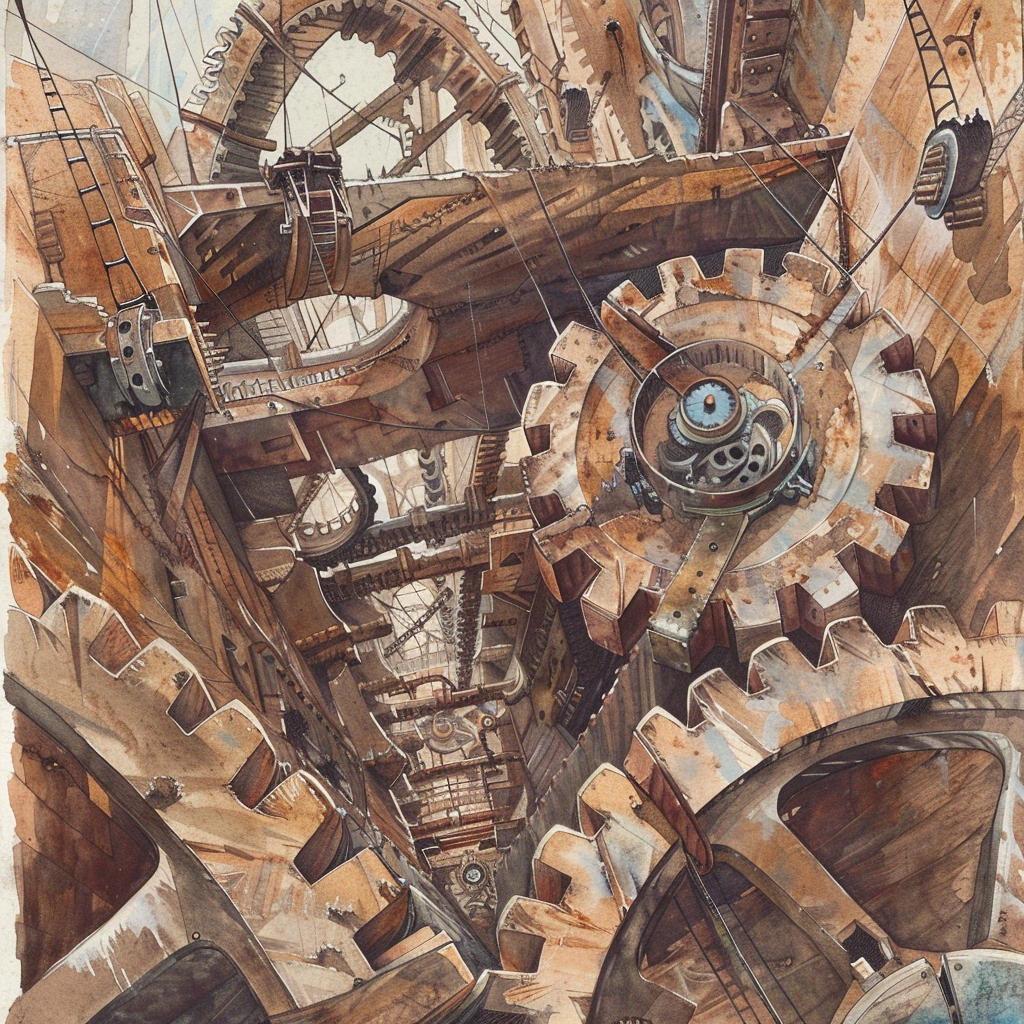
The Milling is the technical name for the edge of a coin. Like its pocket-friendly cousins, the giant coin of Nomisma is also intricately carved with patterns and runes to prevent clipping off precious metals by unscrupulous individuals. And it’s here that they tend to gather, far from the mathematical gaze of the Auditors.
The Reeds: The Reeds are the serrated edges of the giant coin-burg, although at the scale of Nomisma they’re more like metallic cliffs. And if you’ve got the stomach for heights—and a penchant for danger—you’ll want to visit the Edge. The outer rim of the great coin serves as both the city’s boundary and its most secretive feature. From here, you can look out across the infinite expanse of Mechanus, where cog after cog spins away into the distance. But the Edge is also where rogue traders gather, bartering for things that might be best left untraded—like stolen secrets, dangerous artefacts, and black market memories.
Any Guvner can tell you that the greatest crime of Nomismian law is Usury—the practice of making loans that are seen as unfairly enriching the lender. The term may be used in a moral sense—condemning those who take advantage of others’ misfortunes—or in a legal sense, where an interest rate is charged in excess of the maximum rate that is allowed by law. And it’s in the relatively lawless economy of the Milling Quarter that you have to watch out. The Auditors don’t patrol out here, so you’re on your own when it comes to calculating the correct exchange rates or value of trades.
Cutters also say that if you peer over the edge long enough, you’ll catch glimpses of strange economic creatures that dwell in the planar currents between the cogs, that thrive on the detritus of the multiverse’s transactions. Rumour has it that if you toss a coin over the edge, and it lands on the right cog far below, you’ll be blessed with unimaginable wealth.
Current Chant
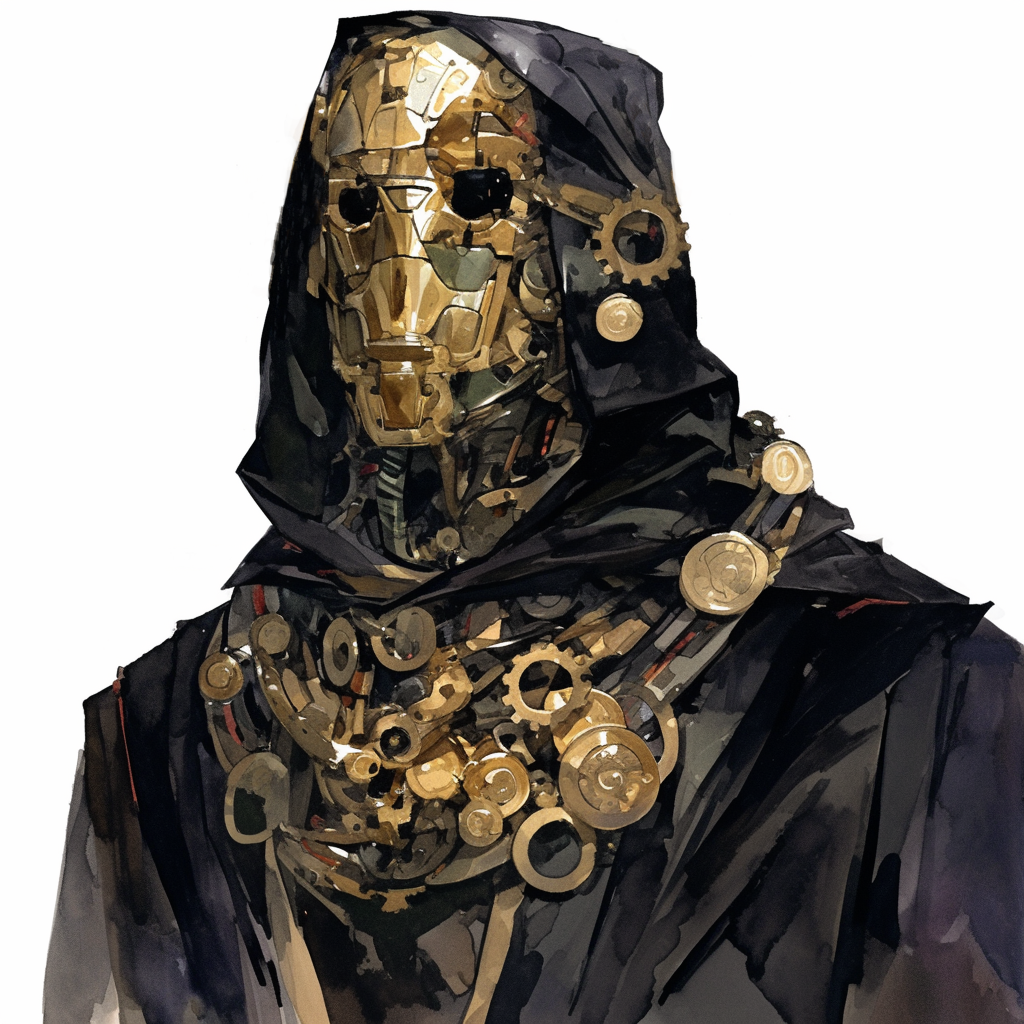
The Remembrancer: Now there’s one figure who knows about the Coin Lords and seeks to topple their rule—the Remembrancer. A mysterious figure who wears a mask shaped from tarnished coins, the Remembrancer is a renegade Numismatist who believes that the Coin Lords are an affront to true value. Once a high-ranking member of the Academy, the Remembrancer uncovered the secret of the Coin Lords and was exiled for trying to reveal the truth.
Now, the Remembrancer lurks in the Milling Quarter, building a secret network of rebels and disenfranchised traders. They claim that wealth, and by extension power, must be earned through honest trade, not manipulated by the whims of ancient coins. Their followers, a group of economic terrorists called the Bankrupt, disrupt the city’s trade through subtle sabotage, rerouting the Flow of Gold and breaking contracts in ways that send shockwaves through the economy.
The Remembrancer’s ultimate goal? To smelt down the Coin Lords and return True Value to the planes—though whether this is for the greater good or some personal vendetta remains unclear. Some say the Remembrancer has been touched by chaos, and seeks to inject unpredictability into Mechanus itself, which could cause the entire coin-city to crumble. Of course, that could just be Auditor screed.
Beneath the calm, orderly surface of Nomisma, a hidden war is being fought between agents of the Coin Lords and the Remembrancer. Both sides are locked in a complex game of strategy and manipulation. The Coin Lords seek to maintain control of the economy, quietly shifting the city’s wealth around to suit their needs, while the Remembrancer and their followers aim to disrupt this carefully ordered balance.
Chrysmos, meanwhile, remains blissfully unaware of the true scope of this conflict, believing their leadership is the key to keeping the city running. They spend their days issuing rulings, overseeing transactions, and keeping the city’s perfect balance intact. Little do they know of the conspiracies all around them.
According the the Remembrancer, no one knows where the Coin Lords came from, or even why they govern the burg in the first place. Some whisper that they’re remnants of a forgotten deity of commerce, split into pieces when this part of Mechanus was first formed. Other chant goes that these coins were the original currency of Mechanus, forged by Axiomites when the first of Mechanus’ cogs began to spin up, and imbued with powerful intellects—but were spent, lost or traded and fell out of circulation. As civilisations invented systems of economics, the Coin Lords somehow drew upon the concepts of trade and debt, becoming quasi-powers in their own right. The most troubling screed however, links one or more of the Coin Lords to Mammon, the baatezu Lord of the Third and King of Greed. Whether he’s trying to scrag them for himself, or whether they’re actually a part of one of his grand get-rich-slowly-but-inexorably schemes, only time will tell.
So while Chrysmos sits on his throne of gold, the Coin Lords calculate beneath the surface, and the Remembrancer plots their downfall, the whole coin-city continues to spin. Until, of course, the balance tips…
See also:
- Money Makes the Cogs Go Around — a song about the Numismatists
- Numismatists — a deep dive into the sect’s philosophy
Source: Jon Winter-Holt, mimir.net. Thanks to KingCorn for the Mammon idea. Canonwatch: Everything described here is homebrew. The Remembrancers were a political position from English history of 1150-1800s. The clerks of the remembrance were responsible for reminding the barons of important financial obligations like paying their taxes. My favourite is the spectacularly-named Remembrancer of First-Fruits and Tenths, who ensured the churches paid the king taxes from their first years collections and 10% of their income.

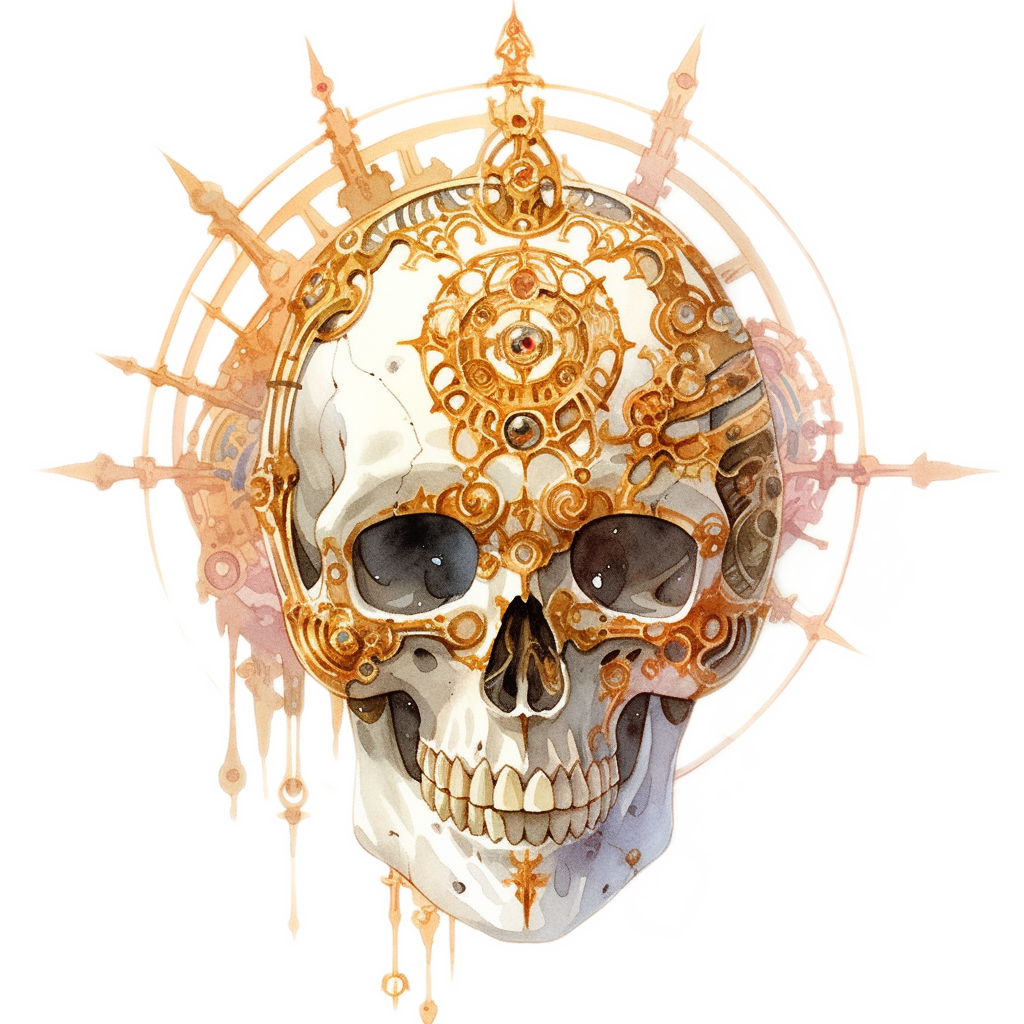
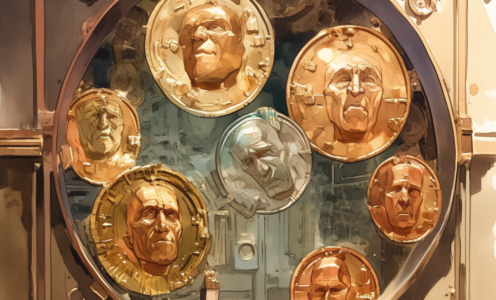
Mammon is absolutely speaking through at least three of the Coin Lords.
Most meetings with them is just Mammon talking to himself. That is my canon for this fanon.
Oh… I love this idea, I’ll edit it in when I get a chance. Thanks!